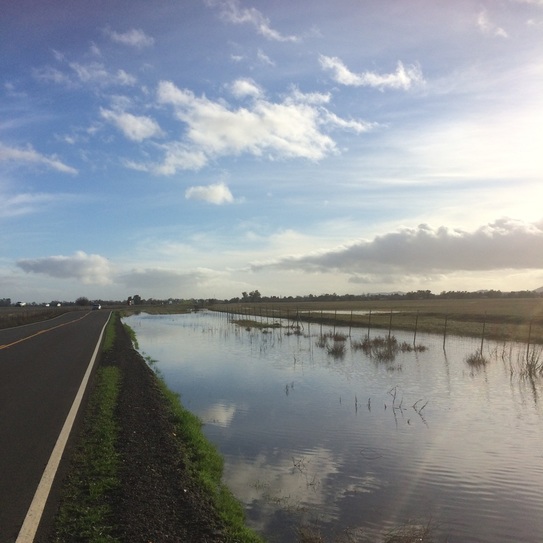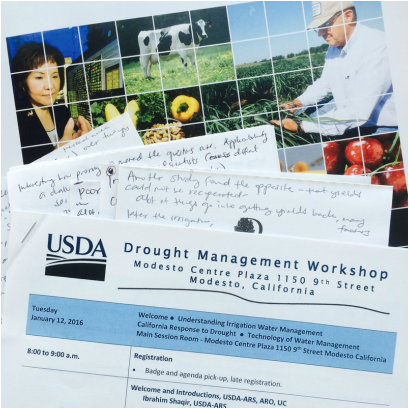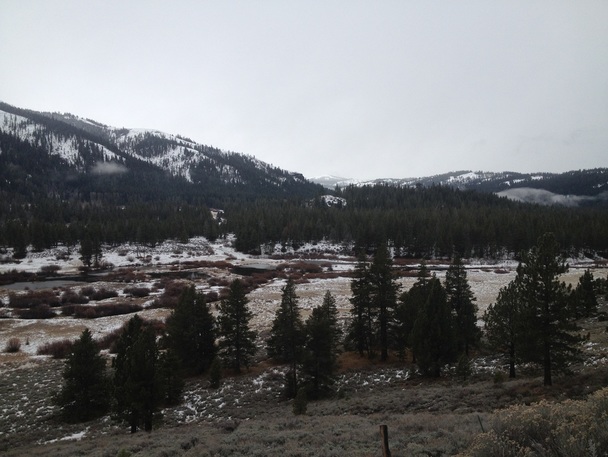Using Current Conditions & a Drought Conference to Ponder the "Merit-Basis" for Policy Change & Aid1/30/2016 Two weeks ago a big storm dumped a lot of rain and caused flash floods across the Bay Area and Sacramento Valley. My personal frustrations with the storm’s inconveniences became apparent quickly, which only frustrated me more (why get frustrated by precipitation, when we need it?). I had to pay nine bucks to use visitor parking after a long and rainy early morning drive from Oakland to Davis. Had to acknowledge that choosing to not wear rain pants was a mistake (jeans soaked). The check engine light came on after I passed through a very large “puddle”. The dog was going completely bezerk in the car——panting so hard from anxiety that he fogged up the windows even with the defroster on. Jones, can you please stop breathing? And while you’re at it, make this rain stop, too? Whoa, wait! Nevermind about that last one! I don’t want the rain to stop——what am I thinking?! The ugly truth is that even with the knowledge I have about the status of the drought and my relatively high tolerance for lots of precipitation, my humanness makes me short-sighted, forgetful, and prone to discounting problems when they seem temporarily resolved. On the drive home, I began to question my judgment on the storm’s intensity. On a scale, how stormy was that storm compared to others I’ve experienced in Northern California over the years? Is the rain and snow we’re getting helping? How much? There are a lot of great sources to help answer these questions. California’s Climate Tracker and NOAA both have data that goes back as far as the late 1800s. (It's worth giving a shout-out to the USDA Natural Resource Conservation Service's site too; among many other things, it compares current precip data to historical averages at specific sites across the country). The California Climate Tracker shows that in December 2015, the state was at 106% of normal precipitation based on historical averages. The precipitation was not evenly spread across the state. The Bay Area and Sacramento Valley were at 50-70% of normal and the foothills and Northern Sierra were at 110-135% of normal, for example (the higher figures in the Sierra is a good thing——we need snow more than we need rain). NOAA provides a sense of variability and relative severity by ranking time periods in terms of their warmth, level of precipitation, and so on. Even though it felt like a lot of rain at the time, this past December was only the 40th wettest (4.47 inches). December 2014, on the other hand, was the 17th wettest (over 6 inches of rain on average). The problem last winter, though, was that December was also the 7th warmest, so we had limited snowfall. Moreover, the state received less than an inch of precipitation in January 2015 and less than 3 inches in February. Although we’ve had a wetter January this year, rain and snow events seem to be dissipating quickly and the temperatures are climbing. There are visible consequences already. So the answer to whether the precipitation the state has received this water year has been helpful seems to be sort of. Of course, it has helped——anything helps!——but the precipitation thus far has not made a huge dent on the drought problem, at least relative to water consumed. Reservoirs are a good way to get the gist of this. Right now, they’re still very low. As of yesterday, all reservoirs are under their total capacity by 50% or more and well below their historical averages. Folsom Lake is at 42% capacity; its historical average for today is 81%. Lake Shasta is at 48%; its historical average for today is 78%. These trends persist across storage systems in California. One reason the rain hasn’t helped fill reservoirs is the length of the on-going drought. Instead of producing run-off, the rainwater seeps into the parched ground. Snowpack usually helps fill reservoirs through the spring and summer, but that depends on how fast the snow is evaporated and melted as temperatures warm up. These facts reiterate what I learned two weeks ago at a Drought Management Conference in Modesto, hosted by the USDA in collaboration with various departments at UC Davis. Researchers and stakeholders in agriculture from California, Israel, and Australia were invited to present their findings and practices to other interested researchers and stakeholders. Why would a political scientist go to such an event? Well I went because my colleague and I are trying to figure out how governments make policy choices and distributive decisions when water resources get tight. We have reasons to believe that these decisions reflect political motivations in some situations. Yet they might also——and likely do——reflect objectives to sustain agriculture, farmer livelihoods, and the environment during these periods. They probably also reflect the scientific uncertainty in how to go about doing these things. To assess the motives that lurk within decision-making, it's important for us to understand what we call the “merit-based” motives that actors in government may take into consideration when changing policy and making investments. Below, I use some of what I learned at the Conference to reflect on what might constitute merit. One merit-based angle governments might consider when investing in solutions and relief to drought is drought severity. In other words, political actors might ask themselves whether and where the drought is bad enough that it necessitates policy change and/or aid. A representative from the California Department of Water Resources explained that the main precipitation window in California is from December 1st through mid-February. Although this has been a rainy winter compared to the last few, we are--as I said earlier--falling short of expectations. And even if additional storms pass through the state due to El Niño this spring, we need well above average (like 200-250+ percent above average) to be a more comfortable with our water situation. The lack of rain and snowfall are not the only problem, however. The world is getting hotter in general, so this El Niño has brought with it characteristics never observed before: cycles of intense storms and then periods of dry and warm conditions. The speaker drove home that storms are not created equal. The degree to which a storm relieves drought is a function of the storm’s timing, flux, duration, direction, freezing elevation, and spatial extent (where the storm travels). The also speaker noted, pretty gravely, that some site records in the Sierra show that the average temperature during winter months was 32.1 degrees in 2014. The problem is not just maintaining snowpack, but getting it at all. Another thing decision-makers might think about when making policy changes or distributive choices is where food crops are grown, and what they require to be grown there. In other words, whether the economic, social, and environmental benefits are such that it makes sense to maintain certain types of production in particular locations. How much water is needed to produce crops——and more importantly, maximize yields——is one element that might inform this call. Yet it became clear at the Conference (and news to me) that how much water is needed to maximize yields is not well understood. Farmers rely on estimates of crop evapotranspiration, or the water loss produced by soil evaporation and crop transpiration (i.e., tree breath), in order to determine the amount of water a crop needs. Estimating crop evapotranspiration is challenging though. The standard estimates require data on temperature, precipitation, and crop characteristics. More advanced estimates would include measures of crop stress such as the level of soil salinity. Researchers from the Department of Land, Air, and Water Resources at UC Davis and from the Golan Research Institute in Israel explained that almost all of these factors can change within a single plot. Whether the individual plant is the north or south side, shaded by tree canopy, or on a slope are just a few elements that impact crop evapotranspiration. Put simply, figuring out the minimum amount of water needed to produce the most food not all that straightforward.
Although not exactly framed in these terms at the Conference, crop resilience to drought stress seems like a factor that might determine merit. The capacity of species to withstand and bounce back from dry conditions varies dramatically, and is a particularly important consideration in food crops like orchards that have high start-up costs and that are more of less 'permanent' once planted. A surprise to me, research shows that almond trees tend to be more resilient than other nut tree types. A recent study found that almond trees exposed to dry-farming (meaning they receive no irrigation) in Kern and Merced counties lost their canopy early in the season and had lower yields. Yet not only did these trees survive the water scarcity, they also rebounded and produced normal yields within two years after returning to a normal irrigation schedule. Pistachio and walnut trees are not as resilient to stress. Presenters discussed mixed results on adaptability, and suggested that walnut trees seem to have the most trouble recuperating after deficit irrigation. It is worth pondering whether crops that can survive and then recover from drought are the most deserving of government support and/or continued to access to water, or whether crops that struggle through it are most deserving. One could argue that farmers growing less resilient crops have the greatest needs for stable water allocations or government funds for innovative technology because farmers that produce more resilient crops can fallow their land and the crop or orchard is more likely to recover. One could also argue, however, that farmers growing less adaptable species should cease growing them in a region with increasingly warmer and drier conditions. Water allocations that reflect a strategy to preserve the most resilient species would ultimately consume less water and leave more water for other purposes such as environmental flows, since these crops and orchards have an easier time maintaining production even when exposed to deficit irrigation. Of course, figuring out which farmers to support or how to create incentives to change how their water use is not that simple. The market value of the crop produced, for example, might play a central role in assessing which farmers need assistance. High-value crops like deciduous nut trees——resilient or not——can often ‘survive’ drought because they create enough profits to cover the cost digging wells in water regimes like California's or to pay for temporary water rights in regimes like Australia's. Farmers growing these crops on a large scale may not need government support at all, although they (and other water users) might benefit if they implement efficient irrigation technology. Another factor that certainly impacts how governments choose to allocate water or funds are prior decisions. Governments seeking to maximize water efficiency are often constrained by the operational rules and infrastructure established in the past. Finally, what the government can offer farmers and whether what they offer reflects merit-based motivations depend on the innovation and solutions available. Agricultural innovations and solutions to water scarcity were the main focus of the Conference (and will be discussed in more detail in a separate blog). Some of these solutions are carried out on the farm. Researchers and extensionists discussed various strategies to maximize yields and protect orchards exposed to deficit irrigation. Reducing irrigation early in the season and maximizing it during critical growth periods (e.g., when the kernel of the pistachio is filling), de-branching trees, and thinning fruit to attain commercial size in those that remain are examples of such strategies. Other non-farm strategies——and ones that require government involvement at some level——include updating canal and reservoir infrastructure, and using recycled or desalinated water for irrigation. Although promising and with some success in Israel, new research and experience has shown that applying recycled and desalinated water to crops can be tricky and has some negative consequences. It seems that we have only a partial understanding on the conditions in which these sources are used and the limits of their use. The uncertainty that comes from innovation makes it even more difficult for governments to make merit-based policy changes or choose solutions to invest in.
0 Comments
Leave a Reply. |
ArchivesCategories |
Proudly powered by Weebly



 RSS Feed
RSS Feed